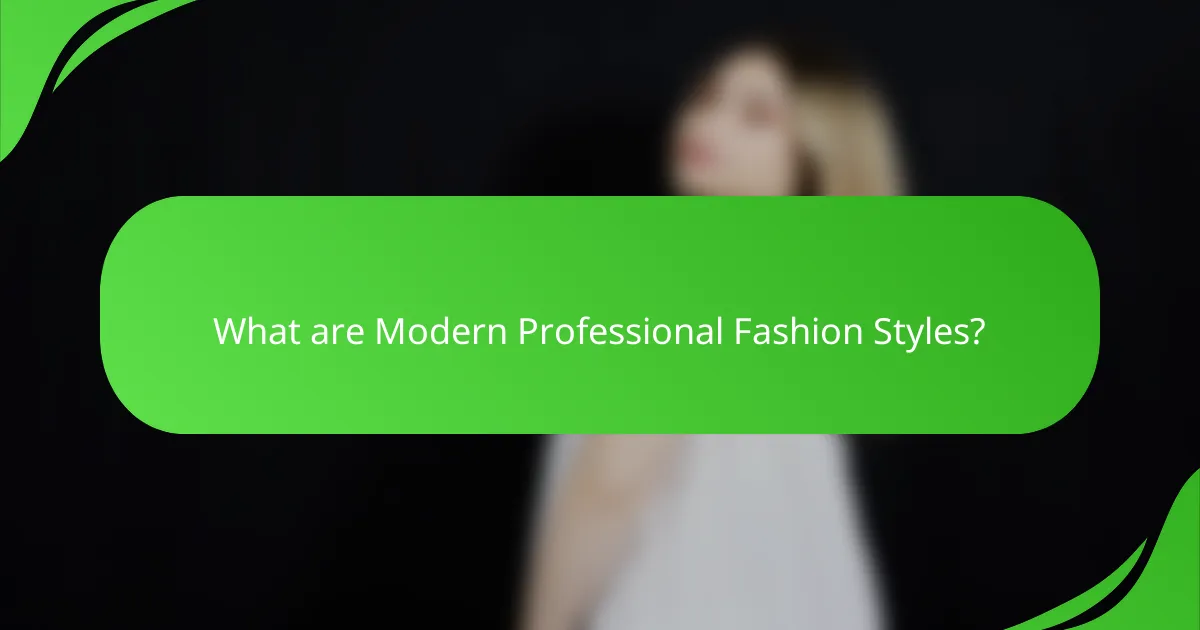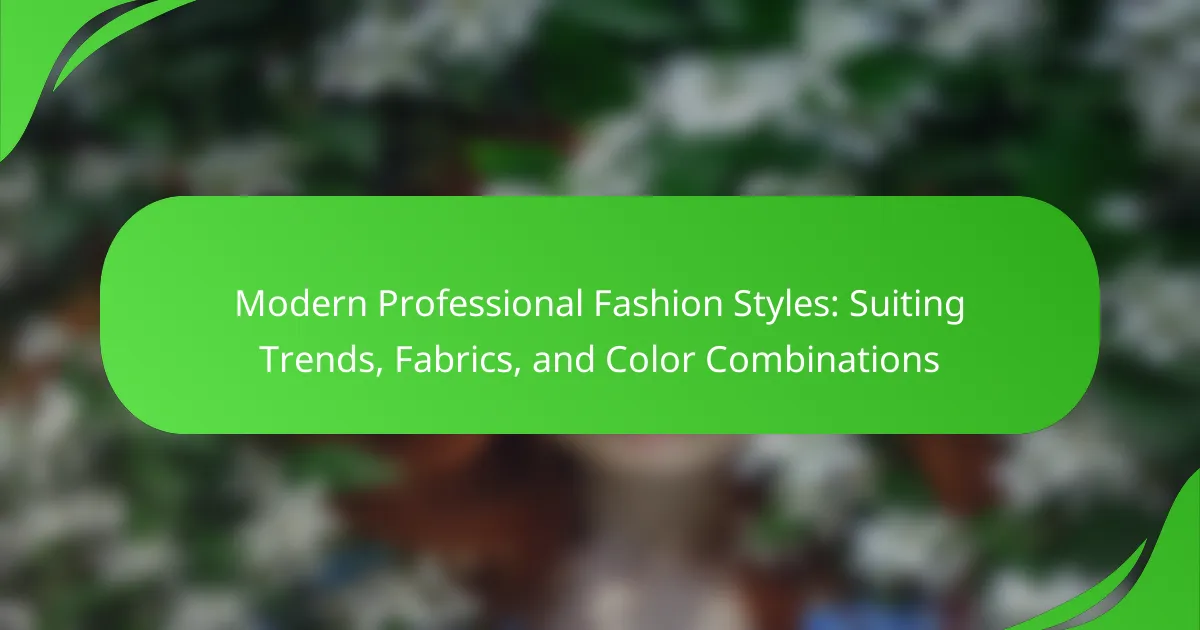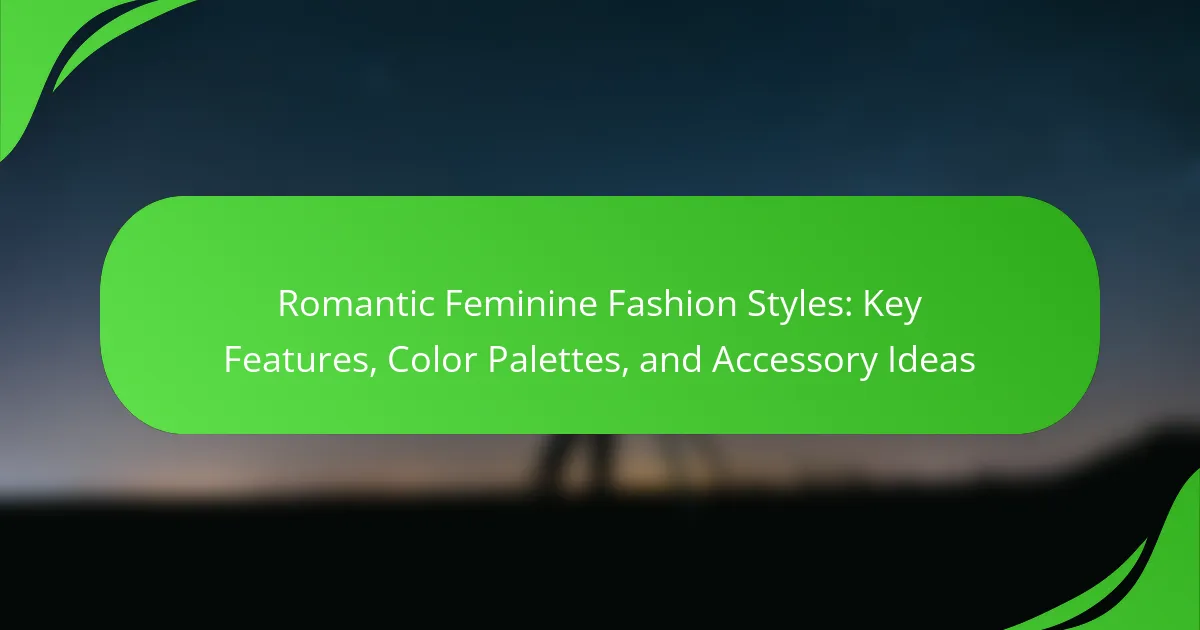Modern professional fashion styles include tailored suits, smart casual attire, and business casual looks. Tailored suits are defined by structured silhouettes and high-quality fabrics, typically in classic colors such as navy, black, and gray. Smart casual attire merges formal and informal elements, featuring items like blazers, chinos, and dress shirts. Business casual offers relaxed fits and lighter fabrics, emphasizing versatility and comfort. Current trends highlight the use of sustainable materials and unique textures, while color combinations often feature muted tones with occasional vibrant accents.

What are Modern Professional Fashion Styles?
Modern professional fashion styles encompass tailored suits, smart casual attire, and business casual looks. Tailored suits are characterized by structured silhouettes and high-quality fabrics. They often feature classic colors like navy, black, and gray. Smart casual attire blends formal and informal elements. This style may include blazers, chinos, and dress shirts. Business casual often allows for more relaxed fits and lighter fabrics. Key attributes include versatility and comfort. Trends emphasize sustainable materials and unique textures. Color combinations often incorporate muted tones with occasional pops of color.
How do suiting trends define modern professional fashion?
Suiting trends significantly influence modern professional fashion by dictating styles, colors, and fabrics. Current trends emphasize tailored fits and minimalist designs. These designs enhance professionalism while allowing for personal expression. Popular colors include muted tones and bold accents, reflecting contemporary aesthetics. Fabrics like wool, linen, and blends offer versatility and comfort. Additionally, the rise of sustainable materials is shaping eco-conscious choices in suiting. Overall, suiting trends create a balance between formality and individuality in professional attire.
What are the key features of contemporary suits?
Contemporary suits feature a tailored fit and modern cuts. They often incorporate lightweight fabrics for comfort. Common materials include wool, cotton, and blends. Many contemporary suits showcase a range of colors beyond traditional navy and gray. Patterns like checks and stripes are also popular. Functional details such as patch pockets and unstructured shoulders are frequently included. Additionally, contemporary suits often emphasize versatility for both formal and casual settings. These features reflect current fashion trends and consumer preferences.
How have traditional styles evolved in the modern workplace?
Traditional styles in the modern workplace have evolved to embrace more casual and diverse fashion choices. Classic business attire, such as suits and ties, is now often replaced by smart casual options. Companies increasingly promote dress-down Fridays, allowing employees to wear jeans and polo shirts. This shift reflects a broader cultural change towards valuing comfort and individual expression. Additionally, fabrics have diversified, with breathable materials gaining popularity for improved comfort. Color combinations have also expanded, moving beyond conservative hues to include vibrant and bold options. Studies indicate that relaxed dress codes can enhance employee morale and creativity. This evolution signifies a balance between professionalism and personal style in today’s work environments.
What role do fabrics play in professional fashion today?
Fabrics play a crucial role in professional fashion today by influencing style, comfort, and functionality. The choice of fabric can determine the overall aesthetic of a professional outfit. For instance, wool is favored for its durability and timeless appeal in suits. Cotton provides breathability and comfort, essential for all-day wear. Synthetic fabrics like polyester offer wrinkle resistance and easy maintenance, which are practical for busy professionals. Additionally, the texture and drape of fabrics can enhance the fit of garments, contributing to a polished appearance. Recent trends show a rise in sustainable fabrics, reflecting a growing demand for eco-friendly fashion in the workplace. According to a 2022 survey by the Fashion Institute of Technology, 75% of professionals prioritize fabric quality when selecting work attire. This highlights the significant impact fabrics have on both personal style and professional image.
Which fabrics are most popular for modern suits?
Wool is the most popular fabric for modern suits. It offers versatility, breathability, and durability. Wool suits are suitable for various occasions. They can be worn year-round due to their temperature-regulating properties. Another popular fabric is cotton. Cotton suits are lightweight and comfortable, ideal for warmer weather. Linen is also favored for its breathability and relaxed aesthetic. It is often worn in summer months. Blends of fabrics, such as wool-polyester, are common for added durability and wrinkle resistance. These fabrics cater to different styles and preferences in modern suiting.
How do fabric choices affect comfort and style?
Fabric choices significantly influence both comfort and style in clothing. Different fabrics offer varying levels of breathability, stretch, and softness. For instance, cotton is known for its comfort due to its breathability and softness. Wool, on the other hand, provides warmth and a structured look, enhancing style. Synthetic fabrics like polyester can offer durability but may lack breathability, affecting comfort. The weight of the fabric also impacts how it drapes and fits, which is essential for style. Lightweight fabrics tend to flow better, while heavier fabrics can create a more tailored appearance. Ultimately, the right fabric choice balances comfort and style, making it crucial for modern professional fashion.
What color combinations are trending in professional attire?
Current trending color combinations in professional attire include navy and gray, black and white, and earth tones. Navy paired with gray creates a sophisticated and versatile look. Black and white remains a classic combination, offering timeless elegance. Earth tones, such as beige and olive green, are gaining popularity for a more relaxed yet professional vibe. These combinations reflect current fashion preferences for balance and professionalism in the workplace.
How do color choices influence perceptions in a professional setting?
Color choices significantly influence perceptions in a professional setting. Different colors evoke specific emotions and associations. For example, blue is often linked to trust and reliability. This is why many corporate brands use blue in their logos. Red, on the other hand, can signify power and confidence. It may evoke strong reactions, making it suitable for leadership roles. Studies show that individuals wearing darker colors are perceived as more authoritative. A 2013 study published in the journal “Color Research and Application” found that colors can affect hiring decisions. The right color can enhance professional image and impact first impressions.
What are the best color combinations for different professional environments?
The best color combinations for different professional environments include navy blue with white, gray with black, and beige with brown. Navy blue and white create a classic, clean look suitable for corporate settings. Gray and black offer a sleek, modern appearance ideal for creative industries. Beige and brown provide a warm, approachable vibe, perfect for client-facing roles. Research indicates that color psychology affects perceptions of professionalism. For instance, blue conveys trust and reliability, while gray suggests sophistication.
How can one transition from traditional to modern professional styles?
To transition from traditional to modern professional styles, one should start by adopting contemporary cuts and fits. Modern professional attire often features tailored silhouettes that enhance body shape. Fabrics have also evolved; choose lighter materials such as blends or performance fabrics for comfort. Incorporating versatile colors and patterns can refresh a traditional wardrobe. Accessories play a crucial role; opt for minimalist designs that complement rather than overpower the outfit. Footwear should reflect current trends, such as sleek loafers or stylish sneakers. Finally, staying updated with fashion trends through resources like fashion magazines or industry blogs can provide ongoing inspiration.
What are the key considerations when selecting a suit for work?
Key considerations when selecting a suit for work include fit, fabric, color, and occasion. A well-fitted suit enhances professionalism and comfort. Fabrics like wool provide durability and breathability, making them ideal for long workdays. Color choices should align with workplace culture; navy and gray are versatile options. The occasion influences style; formal events may require a more tailored look. Accessories like ties and shoes should complement the suit. Quality craftsmanship ensures longevity and maintains a polished appearance.
How can individuals personalize their professional fashion style?
Individuals can personalize their professional fashion style by incorporating unique elements that reflect their personality. This can include selecting specific colors that resonate with them, such as bold hues or muted tones. Additionally, individuals can choose tailored fits that enhance their body shape, creating a more flattering silhouette. Accessories play a key role; items like statement ties, scarves, or unique jewelry can add a personal touch. Fabric choices also matter; opting for textures like linen or wool can convey different professional vibes. Mixing and matching patterns, such as stripes with solids, can create a distinctive look. Finally, considering the workplace culture is essential; aligning personal style with professional expectations ensures appropriateness while still showcasing individuality.
What accessories complement modern professional outfits?
Accessories that complement modern professional outfits include ties, belts, watches, and briefcases. Ties add a formal touch and can express personal style. Belts provide a polished look and ensure proper fit. Watches serve both functional and aesthetic purposes, often symbolizing professionalism. Briefcases or stylish bags enhance the overall appearance while providing practicality. Each accessory contributes to a cohesive and sophisticated professional image.
How can one balance personal style with workplace expectations?
To balance personal style with workplace expectations, individuals should understand their company’s dress code. Research indicates that 65% of workplaces have specific guidelines regarding attire. Adapting personal style within those guidelines is essential. One can incorporate personal flair through accessories or subtle color choices. For example, adding a unique tie or scarf can reflect individuality without violating professional standards. Observing colleagues can also provide insight into acceptable styles. Dressing appropriately while expressing oneself can enhance confidence and professionalism.
What tips can help maintain a modern professional wardrobe?
To maintain a modern professional wardrobe, prioritize quality over quantity. Invest in versatile pieces that can be mixed and matched. Choose neutral colors for easy coordination. Regularly assess your wardrobe to remove items that no longer fit or are outdated. Ensure clothing is clean and pressed before wearing. Follow seasonal trends but keep classic styles as staples. Tailor garments for a perfect fit, enhancing overall appearance. Store clothes properly to prevent damage and maintain shape.
Modern professional fashion styles include tailored suits, smart casual attire, and business casual looks, characterized by structured silhouettes and high-quality fabrics. The article explores how suiting trends influence modern fashion, highlighting key features of contemporary suits, the evolution of traditional styles, and the role of fabrics in enhancing comfort and style. Additionally, it discusses trending color combinations, the impact of color choices on perceptions, and tips for personalizing professional attire while maintaining workplace expectations. Key considerations for selecting suits and maintaining a modern wardrobe are also addressed, providing a comprehensive overview of current fashion dynamics in professional settings.


